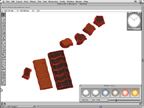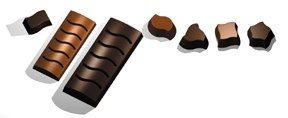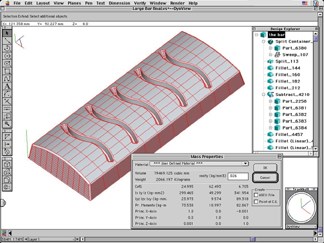CAD Brings Advanced Design Tools to Development of New Starbucks Chocolates
CAD designs and rapid prototyping helped ease the design of a new chocolate product for Starbucks - and helped to bring it to market faster.
David Ryan Design Office (Seattle, WA) - a design office with such clients as Herman Miller, MetroFurniture and Steelcase - recently used CAD in a unique way - to create solid models for a new line of chocolate bars for Starbucks. The use of CAD in this project, which was a first for everyone involved - including the moldmaker - made it possible to use advanced tools such as mass properties analysis, stereolithography and a direct geometry transfer to manufacturing to bring the chocolates to market quickly.
After creating solid models of the chocolate bars using Vellum Solids from Ashlar Inc. (Austin, TX), Ryan used the program's mass properties function to quickly determine the volume of the bars - something that is very difficult to do using traditional chocolate design techniques. "Having CAD models of the bars allowed me to easily make changes to the shape while maintaining the proper volume of the chocolates," Ryan says. "Rapid prototypes created from the solid geometry helped everyone involved in the project - myself, the client and vendors - understand the shape of the product. Transferring geometry in digital format to the moldmaker, a first for that company as well, reduced the time needed to make the molds for the chocolates."
Challenges From All Sides
Starbucks' primary requirement for its new chocolate line was that it have a look that is recognizably Starbucks. For Ryan, that meant creating a basic form that was sensuous, playful and whimsical since these are qualities that people have come to associate with the Seattle-based purveyor of coffee and coffee-related products. In addition to being immediately recognizable as one of its products, Starbucks wanted the design to be unique so that they could patent it. Starbucks was not planning to develop just one chocolate product, however. They were eventually going to sell an entire family of chocolates, including a small bar, a large bar and bite-size pieces. They did not want all the pieces to be identical, but it was important that each would be immediately identified as part of the product family. That added to the challenge because it meant that the original sensuous, playful and whimsical form had to be one from which Ryan could spin off a range of shapes.
The demands of the chocolate-making process added other considerations to the design. Chocolates are produced by pouring liquid into a mold in a traditional casting process. This requires the shape of the finished product to include a certain amount of draft angle so that hardened pieces can be removed from the mold. The casting process also dictated a minimum size of the radii because you don't want to have edges breaking off when they come out of the mold. When that happens, the bits that remain in the molds create imperfections on the next piece to be cast.
When Ryan took on this project, he had been using a 3-D CAD program, Vellum 3D, for a number of years. This was the program that the graduate industrial design students used when he was a professor at University of Illinois. He had chosen Vellum 3D for the students because it was an intuitive program that let them focus on design rather than on learning CAD. When Starbucks asked him to take on the chocolate project, his firm had not used solid modeling, but he was aware of the benefits of the technology. Since this was a relatively simple project in that the product had no moving parts, he decided to give solid modeling a try. He chose Vellum Solids because he had heard that it was as intuitive as Ashlar's regular 3-D product.
Variations on a Theme
Ryan started the project by coming up with the basic form for the chocolates, a 3-D abstraction of the letter S. From that, he began creating variations on that form, which he showed to the client. All the work at this point was done on paper. Once Starbucks had selected one of the design themes, he made some Styrofoam and wood prototypes to see if the idea was flexible enough to cover a range of chocolate products.
At this point, when Ryan believed he was close to what would become the final design, he started modeling the shape in Vellum 3D, first creating it as a wireframe model. Although the abstract S shape was quite complex, the modeling went very quickly. The software eliminated the need to do a lot of zooming in and out through its patented Drafting Assistant feature. For example, the S shape of these chocolates required numerous ellipses, to which other geometric elements such as lines were connected. With other CAD programs, if you want to run a line from the exact point where the major and minor axes of an ellipse come together - also known as the vertex of the ellipse - you have to zoom in to find the location of the vertex. Then you zoom out to place your line. With Vellum 3D, Ryan simply moved the cursor in the general area of the vertex. The software identified the vertex and let him add his line at that exact point. This way, he wasn't interrupting the flow of the modeling process.
Another feature that was very helpful in this regard was the ability to make a basic shape first and then come back later and give it the correct dimensions. He did this using Vellum's Edit Objects box, which presented all the information about a line or curve and allowed him to alter it by typing in another value. Once the wireframe model was finished, he used the software's autosurfacing capability to add the "skin."
The resulting surface model was then imported into Vellum Solids. Ryan used that program's stitching capability to sew the skins together and create a solid model. The design still required some fine-tuning at that point and since this was his first use of solid modeling, Ryan consulted with James Kyroudis of Chicago, Illinois - a longtime Vellum Solids user - to assist him. Kyroudis helped Ryan refine the radii and draft angles and adjust the volume and heights of the pieces. Ryan noticed that because this solid modeling program had similar intuitive features to Vellum 3D, such as the Drafting Assistant, he was able to do a lot of this work himself. Picking a point on a solid model, such as the edge of a plane that he wanted to extend to adjust height, for instance, was accomplished by moving the cursor in the general area of the plane until the software identified the point. In addition, he could make fairly difficult modifications, such as a change to a draft angle, by entering a new value in the Edit Objects box. The model was instantly regenerated with the new dimensions. Kyroudis helped Ryan take advantage of the software's rendering tool to create very attractive images of the chocolates to show to the client.
Solid Advantages
One of the big advantages to using a solid modeler on this project was how easily Ryan was able to determine the weight of the different chocolate products. In the past, a company such as Starbucks would have sent technical drawings of a chocolate piece to a moldmaker, who would have used the drawings to make a model of the piece. They would have made a vacuum form based on the model and filled the cavity with chocolate. Weighing the chocolate would have given them the final weight. With a complex shape such as the one Ryan had created, this process would have been very time-consuming. And if the weight was not right, he would have changed the design and gone through the entire process again. This would have been repeated until he got the exact weight that Starbucks wanted.
"With the solid model," Ryan says, "I simply supplied the program with the specific densities of the chocolate and let it determine the weight automatically. Increasing or decreasing the weight was done by altering the geometry. After making a change, I ran the mass properties analysis again for immediate feedback. With this approach, achieving the desired weights for the pieces went very quickly. The German-based moldmaker Starbucks had selected for this project had never been exposed to this method of determining weight. They were pleasantly surprised when our prediction turned out to be highly accurate."
Another benefit of doing this project with solids was the ability to make rapid prototypes from the CAD geometry. These models were helpful in Ryan's presentations to Starbucks, and also to the California-based company that was going to put the foil onto the chocolates and package them. They used the stereolithography models to verify that they could foil the complex shape.
Ryan also sent some of the prototypes to the moldmaker in Germany to give them a better feel for the final product. Since Starbucks was interested in getting the chocolates on the market as soon as possible, the moldmaker agreed to work directly from the Vellum geometry rather than from drawings. This was a first for that company, and it did not have a CAD system but took the IGES files to another toolmaker that did. By creating the toolpaths that machined the mold cavities directly from solid models, the vendor was able to significantly reduce the turnaround time on these molds.
Starbucks' chocolate line was launched successfully and customers can now enjoy several items from the new product family: the small bar and a bite-size piece called an ingot. Other items will be introduced in the near future. The chocolates come in four basic flavors - milk chocolate, mocha, dark chocolate and dark mocha. Some pieces have other flavors such as peanut butter or raspberry added to the basic chocolate foundation. "Starbucks was pleased with the distinctive shape I created," Ryan notes, "and also with the solids-based development process. Although it was a first for everyone involved, the use of CAD and related technologies to create chocolates turned out to be a very tasty experience."
Related Content
MMT Chats: Eliminating the Noise to Stay Focused on the Customer
Metro Mold & Design joins me to discuss the value of the 80/20 rule as a business strategy, its talented cross-functional team, the role of automation in mold building and molding, and the continuing impact of COVID-19.
Read MoreHow to Use Scientific Maintenance for More Accurate Mold and Part Troubleshooting
Discover how adopting scientific maintenance approaches helps improve mold lifespan, minimize failures, and optimize production outcomes.
Read MoreThe Role of Social Media in Manufacturing
Charles Daniels CFO of Wepco Plastics shares insights on the role of social media in manufacturing, how to improve the “business” side of a small mold shop and continually developing culture.
Read MoreHands-on Workshop Teaches Mold Maintenance Process
Intensive workshop teaches the process of mold maintenance to help put an end to the firefighting culture of many toolrooms.
Read MoreRead Next
Are You a Moldmaker Considering 3D Printing? Consider the 3D Printing Workshop at NPE2024
Presentations will cover 3D printing for mold tooling, material innovation, product development, bridge production and full-scale, high-volume additive manufacturing.
Read MoreHow to Use Strategic Planning Tools, Data to Manage the Human Side of Business
Q&A with Marion Wells, MMT EAB member and founder of Human Asset Management.
Read MoreHow to Use Continuing Education to Remain Competitive in Moldmaking
Continued training helps moldmakers make tooling decisions and properly use the latest cutting tool to efficiently machine high-quality molds.
Read More
























